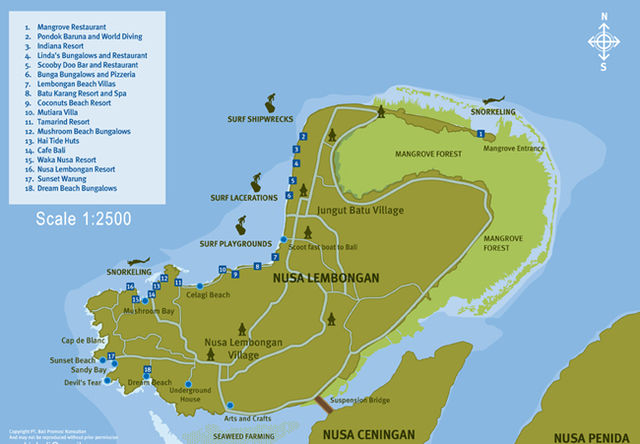Top Qs
Timeline
Chat
Perspective
Nusa Lembongan
Island in Indonesia From Wikipedia, the free encyclopedia
Remove ads
Nusa Lembongan (Balinese: ᬦᬸᬲᬮ᭄ᬮᭂᬫ᭄ᬩᭀᬗᬦ᭄, romanized: nusa lĕmbongan) is an island located southeast of Bali, Indonesia. It is part of a group of three islands that make up the Nusa Penida District in Klungkung Regency, of which it is the most famous of the three islands of Nusa Penida, Nusa Lembongan, and Nusa Ceningan - known together as the "Nusa Islands".[1] This island group, in turn, is part of the Lesser Sunda Islands.
Remove ads
Administration
Administratively, the island is part of the Nusa Penida district of Klungkung Regencyand is divided into 2 villages, namely Jungutbatu village which administratively occupies the northern part of the island and Lembongan village which administratively occupies the southern part of the island and the entire island of Nusa Ceningan. Nusa Lembongan is one of three small offshore islands that make up this district, the others being Nusa Penida and Nusa Ceningan.[2] Nusa Lembongan has the vast majority of the tourist infrastructure within the district and is the most popular destination for visitors to the Nusa Islands as it has the most accommodation and dining options for travellers from Bali and Lombok.[3]
Remove ads
Geography
Summarize
Perspective



Nusa Lembongan is approximately 8 square kilometres in area with a permanent population estimated at 5,000.[4] Twelve kilometres of the Badung Strait separates Nusa Lembongan from Bali Island. The island is surrounded by coral reefs with white sand beaches and low limestone cliffs. Nusa Lembongan is separated from Nusa Ceningan by a shallow estuarine channel which is difficult to navigate at low tide. There are no permanent waterways on Nusa Lembongan. There is a suspension bridge linking Nusa Lembongan and Nusa Ceningan which takes foot and motorbike traffic only.
There are three main villages on the island. Jungut Batu and Mushroom Bay are the centres of the tourist-based industry and activities on the island[5] whilst much of the permanent local population resides in Lembongan Village.
To the east, the Lombok Strait separates the three islands from Lombok and marks the biogeographical division between the fauna of the Indomalayan realm and the distinctly different fauna of Australasia. The transition is known as the Wallace Line, named after Alfred Russel Wallace, who first proposed a transition zone between these two major biomes.
The northeastern side of the island is flanked by a relatively large area of mangroves totaling some 212 hectares.[6]
Nusa Lembongan is served by regular direct speed-boat services, mostly from the east-coast Bali resort town of Sanur. Crossing time is approximately 30 minutes and services run at regular intervals during daylight hours. Larger cargo boats also run daily from the Bali port town of Padang Bai.
The island is populated by very few cars. Its main source of transportation is by scooters and foot, due to the small size of the island.
Remove ads
Local economy

The economy is largely based on tourism and Nusa Lembongan is the only one of the three neighbouring islands to have any significant tourism-based infrastructure. Nusa Lembongan is particularly well known as a world-class surfing destination, with famous surf breaks including Shipwrecks, Lacerations & Playgrounds.[7] The island is also known for its surrounding world-class scuba diving and snorkeling on the coral reefs.[8] There is also subsistence agriculture and fishing[9] on the island, and a seaweed farming micro-industry until as recently as 2015 when due to tourism and pollution it became nonviable.[10] Following the covid pandemic and subsequent lag in tourism, seaweed farming came back in Nusa Lemponbang in 2020.[11]
The island also contains several guesthouses and even a small gym at a resort.[12]
Conservation

Marine conservation is considered extremely important to sustaining future levels of tourism on the island[8] and in February 2009, a local NGO from Nusa Lembongan, facilitated by The Nature Conservancy Coral Triangle Center, opened a community centre on Nusa Lembongan. The waters around Nusa Lembongan and Nusa Penida have at least 247 species of coral and 562 species of reef fish.[13]
Other conservation initiatives include a release programme of vulnerable olive ridley turtles from Sunset Beach on the southwestern coast.[14][15]
Remove ads
Connection to Nusa Ceningan


It is connected to Nusa Ceningan Island through a narrow suspension bridge who collapsed in 2016 and rebuilt.[16][17]
Gallery
- View of Jungut Batu Beach from the south side
- View of Jungut Batu Beach from the north side
- Sunset over Jungut Batu
See also
References
External links
Wikiwand - on
Seamless Wikipedia browsing. On steroids.
Remove ads










